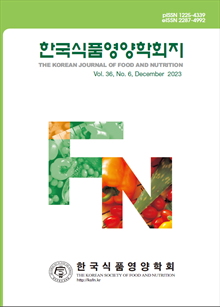간행물
한국식품영양학회지 KCI 등재 The Korean Journal of Food And Nutrition

- 발행기관 한국식품영양학회
- 자료유형 학술지
- 간기 격월간
- ISSN 1225-4339 (Print)2287-4992 (Online)
- 수록기간 1988 ~ 2024
- 주제분류 자연과학 > 생활과학 자연과학 분류의 다른 간행물
- 십진분류KDC 594DDC 641
권호리스트/논문검색
Vol. 27 No. 6 (2014년 12월) 23건
21.
2014.12
구독 인증기관 무료, 개인회원 유료
The purposes of this study were to investigate the eating of breakfast by female middle school students in Seoul, the perception of the school breakfast program (SBP), and determine the factors affecting the intention to participate in SBP. Out of 340 questionnaires distributed to the female middle school students, 334 were returned (98.2% response rate) and 323 were analyzed. The subjects were categorized into two groups by the intention to participate in SBP. Subjects were classified as participating and non participating groups. As a result of analyzing the breakfast intake frequency, 'hardly eat' showed the highest with 18.5% in the participating group and 10.3% in non participating group, while 'eat every day' showed 38.2% in the participating group, and the highest with 65.5% in non participating group (p<0.001). For the reason for skipping breakfast, 'no time' showed the highest with 30.0% in the participating group, 'over sleep' and 'no appetite' showed the highest with 24.8% in non participating group. For the reason for not participating in SBP, 'breakfast should be eaten at home' showed the highest with 47.2% in non participating group and 'may get up early in the morning' showed the highest with 46.2% in participating group (p<0.01). To determine the factors affecting the intention to participate in SBP, logistic regression analyses were conducted for female middle school students. According to the logistic regression analysis, father's education level was independently associated with the intention to participate in SBP in female middle school students [Odds Ratios (OR) 2.38, 95% Confidence Interval (CI) 1.03~5.52]. Frequency of eating breakfast on weekdays (OR 1.36, 95% CI 1.01~1.81), Level of need for school breakfast (OR 0.52, 95% CI 0.35~0.76) and whether to approve school breakfast (OR 0.27, 95% CI 0.18~0.41) were independently associated with the intention to participate in SBP in female middle school students. In conclusion, proper educational efforts for importance of school breakfast could be useful plan to develop school breakfast program.
4,300원
22.
2014.12
구독 인증기관 무료, 개인회원 유료
This study was conducted to develop for the elderly food that is safe, well-shaped, and easy to chew and swallow, using gelification. Gelatin, which has low adhesiveness, thereby lowering the possibility of being swallowed wrongly into the respiratory track, was used as a viscosity agent for the gelification. Water and gelatin amounts were adjusted to facilitate breaking the food with the tongue. Various foods for the elderly with chewing and swallowing difficulties were used for sensory assessment. Sensory panel consisted of 10 dietitians (10 women) in nursing care facilities. The sensory optimal composite recipes were determined by central composite design (CCD). The sensory measurements were significantly different in appearance (p<0.05), saltiness (p<0.05), sweetness (p<0.01), and overall quality (p<0.05). The optimum formulation of the Korean barbecue beef calculated by numerical and graphical method was 3.71 g of sugar and 19.53 g of soy sauce. Moisture content, hardness and adhesiveness of the Korean barbecue beef were 78.85%, 2.40, -1.87, respectively. The result shows that food for the elderly, which is easy to chew and swallow, using gelification will have sufficient competitiveness in terms of safety, taste, and preference. The development of food for the elderly that take into account the difficulties in chewing and swallowing among the elderly, reflects their preference, and has sufficient nutrients, is important to enable the elderly to enjoy their meals. Also, as the Korean society is getting older, it remains one of the biggest social challenges.
4,000원
23.
2014.12
구독 인증기관 무료, 개인회원 유료
The object of this study was to employ effective marketing methods using SNS by determining how food-related SNS usage characteristics have influence on dine-out motivation and restaurant satisfaction and how this affects people's quality of lie. Survey respondents were men and women who have had used some kinds of food-related SNS. The survey included general characteristics of respondents, food-related SNS usage characteristics, dine-out motivation, restaurant satisfaction, and food-related quality of life. Food-related SNS usage characteristics were divided into convenience, effective time-spending, and informative; Dine-out motivation was sorted into entertainment motivation and social motivation by factor analysis. Analysis of the connections between the variables by AMOS showed that among food-related SNS usage characteristics, convenience did not have a significant influence on either entertainment or social motivation. Informative had a positive effect on entertainment motivation (p<0.05), but not on social motivation. On the other hand, effective time-spending through food-related SNS had an impact on both entertainment (p<0.001) and social (p<0.05) motivation. Moreover, the effect of dine-out motivation on restaurant satisfaction showed that entertainment motivation (p<0.05) and social motivation (p<0.01) both have significant influences on restaurant satisfaction. Also, restaurant satisfaction turned out to affect quality of life (p<0.05). As a result of this study, the usage of food-related SNS did not directly influence customers' restaurant satisfaction and quality of life; (p<0.05). As a result of this study, the usage of food-related SNS did not directly influence customers' restaurant satisfaction and quality of life; however, it had an impact on dine-out motivation and gain pleasure of dining out and help improve the quality of life in the long run; thus, it is believed that marketing strategies thorough SNS by restaurant industry are required.
4,200원
1
2

